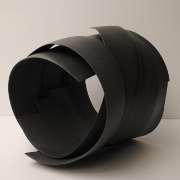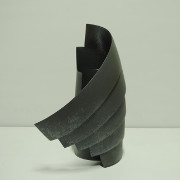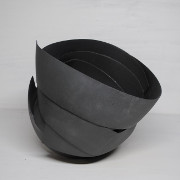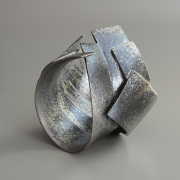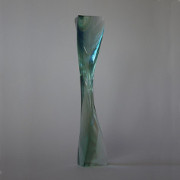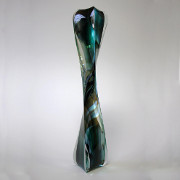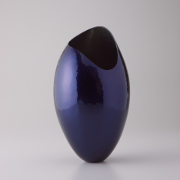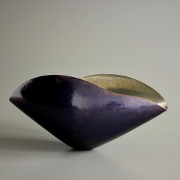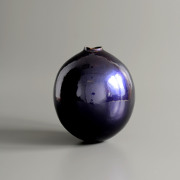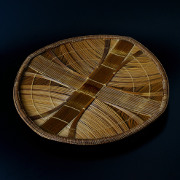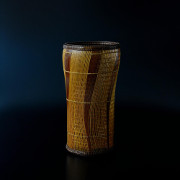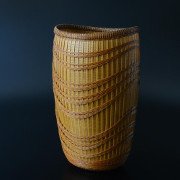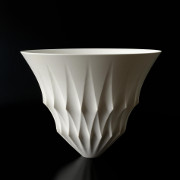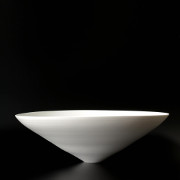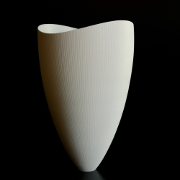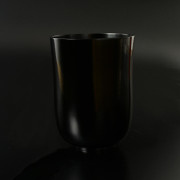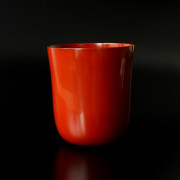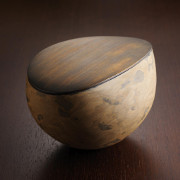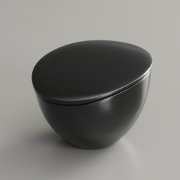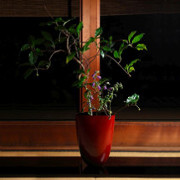|
The gallery's focus Japan will come into its own from the 10th of August to the 21st of September. Another cooperation with Yufuku Gallery Tokio is titled“The Beauty of Materials” showing not only ceramics but also Japan's highly advanced craftsmanship treating glass, metal, lacquer and bamboo. This delicacy is prepared for all friends of the culture of the Far East by opening speaker Dr. Nora von Achenbach, head of the East Asian and Islamic Art department at the Museum für Kunst & Gewerbe Hamburg.
Maasaki Yonemoto (glass) Suko Buseki (bamboo)
Ryota Nishikata (metal) Keikoh Nishimura (lacquer)
Yoshinori Ohno (porcelain) Kanjiro Moriyama (stoneware)
Examples:
1. Masaaki YONEMOTO (* 1987)
About the Artist
If the metropolises of the next millennium are futuristic pyramids in glass, Masaaki Yonemoto’s (1987- ) skyscrapers would reign bright in the night sky, glistening softly in their incandescent splendour. Born in Yamaguchi and currently residing in Toyama, Yonemoto is a young artist, yet his talent is undisputed. Graduating head of his class at the Kurashiki University of Science and the Arts in 2010, and further completing his graduate studies at the Toyama City Institute of Glass Art, Yonemoto has received more than 11 major awards in glass in the three years since leaving university. Ultimately, the artist strives to achieve a lyrical ‘architectural minimalism in glass’ that combines the beauty of a basic outer facade coupled with the beauty of a revealed interior that is at once complex and striking.
2. Ryota NISHIKATA (* 1978)
About the Artist
Hailing from the small village of Yahiko in Niigata Prefecture, adjacent to the city of Tsubame (world famous for its metal and steel industry), Ryota Nishikata (1978- ) wields the hammer with incredible precision and artistry. With talent and discipline far beyond his years, Nishikata’s work exhibits his ability to forge a riveting three-dimensional object from a single sheet of copper, amalgamated with the most fascinating and rarest of blues upon his copper bodies. In fact, such blues are a family secret passed down for three generations and first devised by his grandfather, unable to be copied by other metal artists. With elegant forms and subtle purplish blue hues, Nishikata’s hammered copper is quickly gaining a global following.
3. Kanjiro MORIYAMA (* 1984)
About the Artist
The idyllic kiln site of Koishiwara in Fukuoka Prefecture in Kyushu is known throughout Japan as a centre of Mingei pottery. Yet from this traditional locale comes great innovation in the work of the young Kanjiro Moriyama (1984- ), a ceramic artist who embraces the clay of his hometown yet with a penchant for the sculptural, invoking the abstract forms of his idols Shigekazu Nagae and the stoneware curves of Ken Mihara. Captivating the Japanese ceramic scene in 2007 by being the youngest Grand Prix winner of the prestigious Asahi Ceramic Exhibition at the age of 23, and winning a slew of awards since, he had just marked his first international debut this year.
4. Yoshinori OHNO (* 1978)
About the Artist
Capturing the vicissitudes of life and death in his solemn porcelain, Yoshinori Ohno (1978- ) is a dreamer, a purist, and at the same time, a philosopher, for what is imprinted upon his porcelain silhouettes are questions pertaining to the very existence of man, of where have we been, where we are now, and where are we going. Ohno’s vessel forms are manifestations of life itself. Having lost his father at a young age, it is this internal struggle to contemplate and understand the powers of fate that has led the artist to create porcelain as not only a means of self-expression, but as a means to comprehend the world around him. Ohno was one of seven Japanese artists to be invited to the Vallauris Biennale at the Picasso Museum in 2012, and since, his fanbase, both in Japan and abroad, has increased tenfold.
5. Suikoh BUSEKI (* 1958)
About the Artist
The art of bamboo weaving is an age-old craft, nurtured in part by the sheer abundance of bamboo found throughout the natural landscapes of Japan, and also by the inherent fondness of the Japanese towards this austere yet robust material. Bamboo basketry is an intricate art, requiring not only extreme concentration and technique, but the ability to cut and weave a compelling material that is at once inflexible, yet surprisingly elastic when pushed to its limits. Suiko Buseki (1958- ) is a third-generation bamboo artist, and one of the few remaining bamboo artists who continue to work in Tokyo’s old district of Arakawa. After training under his father Suigetsu, Buseki would apprentice under the former Living National Treasure Shokansai Iizuka. Surprisingly, he is also one of the very few artists who had the honour of training under 2 Living National Treasures, the second being Shokosai Hayakawa, and this educational profile is vivid testament to the skills of Buseki, who has matured to receive several of the top prizes at the prestigious Japan Traditional Art Crafts Exhibition, held annually in Japan.
6. NISHIMURA Keikoh III (*1966)
About the Artist
Keikoh Nishimura III (1966 - ) is a 3rd generation lacquer artist, born and bred in the aesthetic legacies of the ancient capital of Kyoto, and was formerly the lacquerer of the finish found on many of the latter-period works of Mutsumi Suzuki, the legendary lacquer artist long represented by Yufuku since its inception in 1993. Suzuki’s sudden death on the last day of Collect 2009 took the Japanese art world by surprise, and the artist is still fondly remembered by fans and collectors alike as one of the greatest lacquer artists of his generation. His works pushed the boundaries of lacquer to new heights. Smooth yet full of warmth, strong yet incredibly light, both form and function united in elegant harmony within Suzuki’s lacquer. Luckily, his aesthetics live on in the works of the still-youthful Nishimura, who formally trained with Suzuki’s elder brother, Nitten lacquer artist Hyosaku Suzuki III, and his own father, Keikoh Nishimura II.
|

